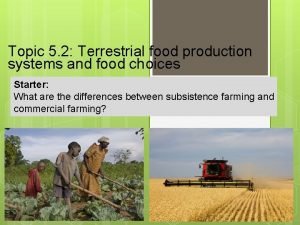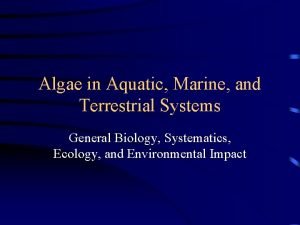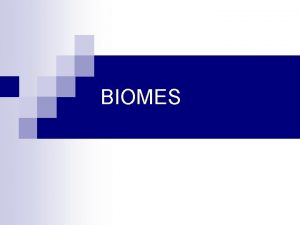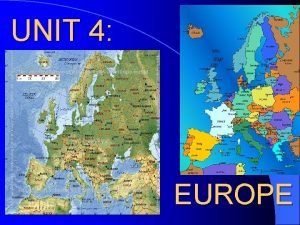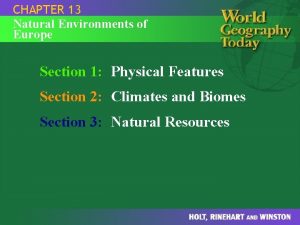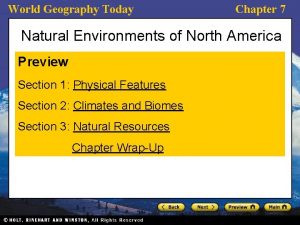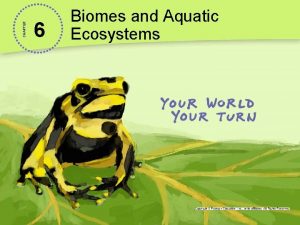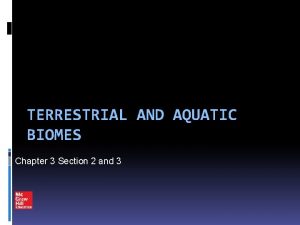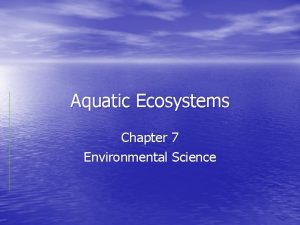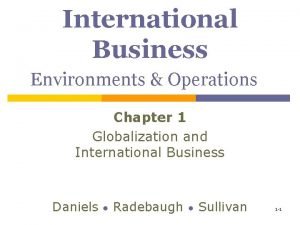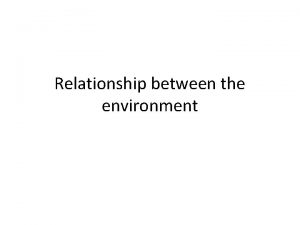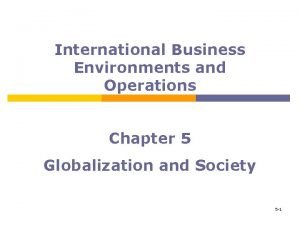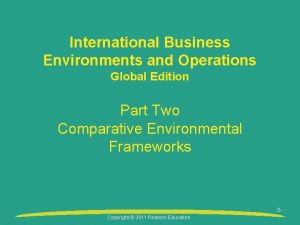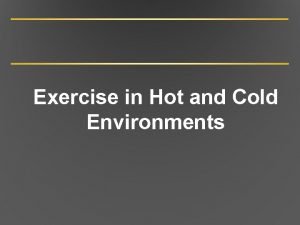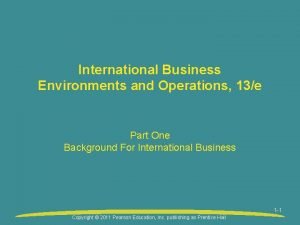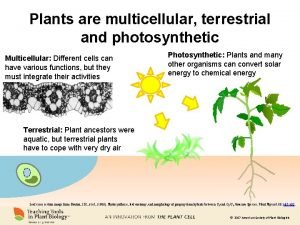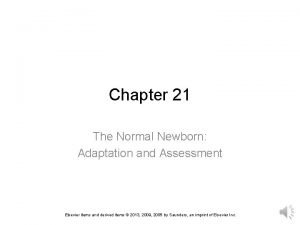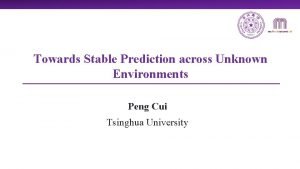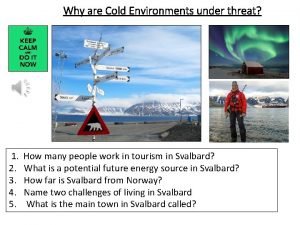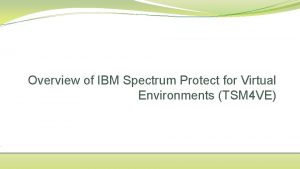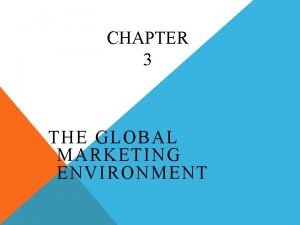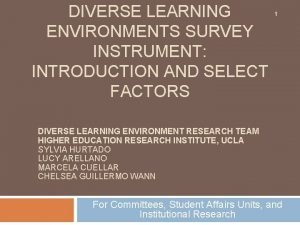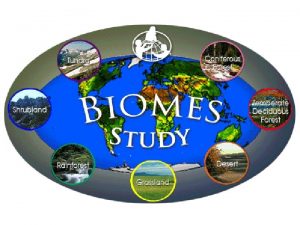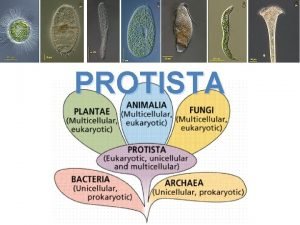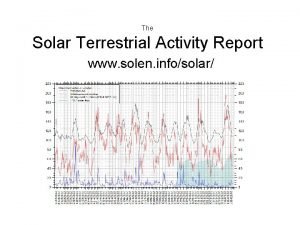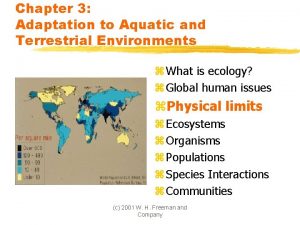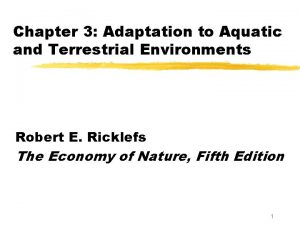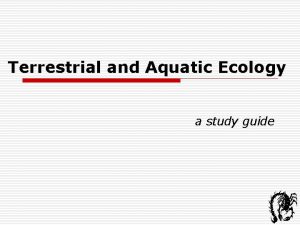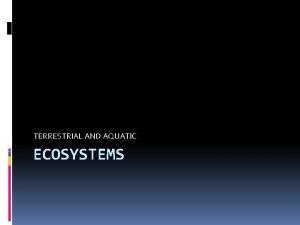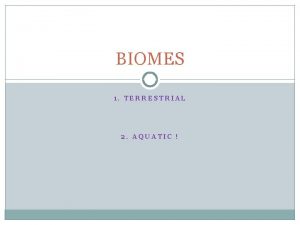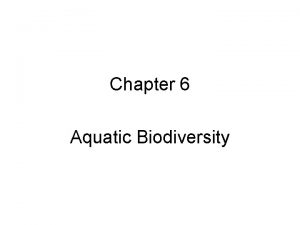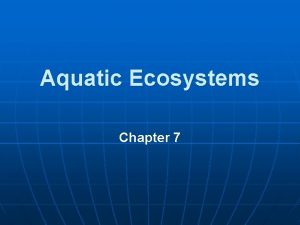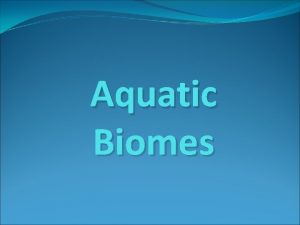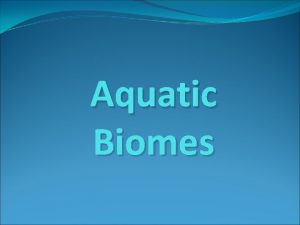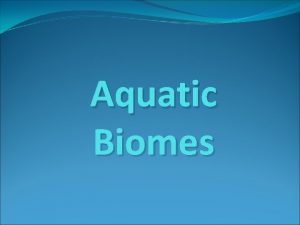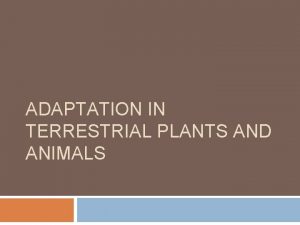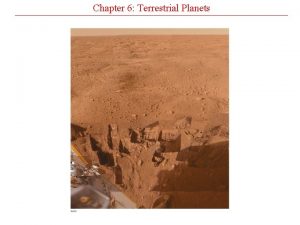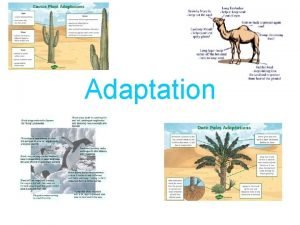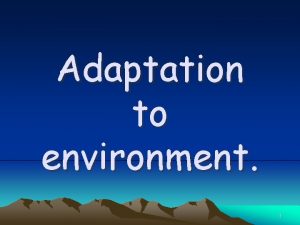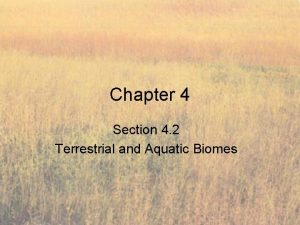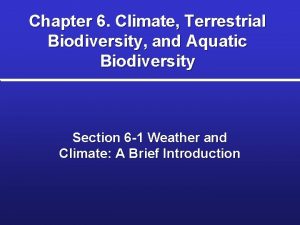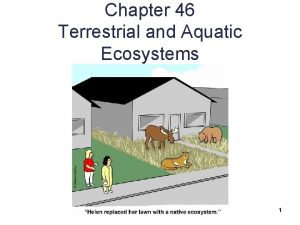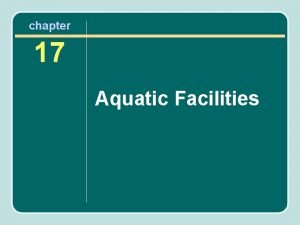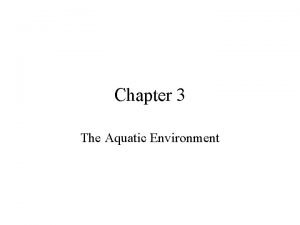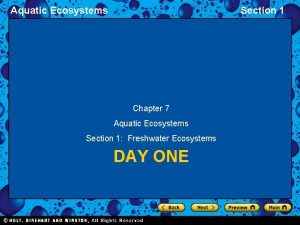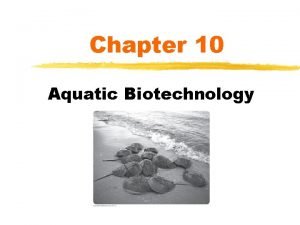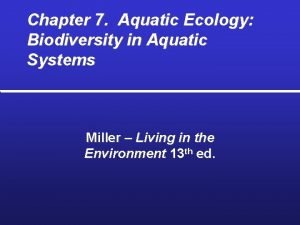Chapter 3 Adaptation to Aquatic and Terrestrial Environments













































- Slides: 45

Chapter 3: Adaptation to Aquatic and Terrestrial Environments Robert E. Ricklefs The Economy of Nature, Fifth Edition 1

Chapter Overview - Basics z. The physical world both provides the context for life and constrains its existence. z A world of environmental factors. . . yresources: water, minerals and food items yconditions: temperature and relative humidity z. Most factors have extremely wide ranges: yeach type of organism is typically adapted to a narrow range of each factor 2

Chapter Overview - Regulation z. Organisms typically contrast with their external environments: yinternal conditions are maintained +/- constant yfluxes of heat and substances must be regulated ybut organisms are open systems. . . xresources must be acquired xwastes must be eliminated z. How do organisms accomplish this? 3

Chapter Overview - Bottom Line z. It is important for us to understand the mechanisms organisms use to interact with their environment. z. This understanding may lead to insights: ywhy organisms are specialized ywhy organisms have specific geographic distributions ywhy certain adaptations are associated with certain environments 4

What’s next? z. This chapter examines adaptations by considering various challenges facing organisms, for example: yhow do plants acquire water and nutrients from soils and transport these? yhow do plants carry out photosynthesis under varied environmental conditions? yhow do plants and animals cope with extremes of temperature, water stress, and salinity? 5

Availability of Soil Water z. Water molecules are attracted to: yeach other (causes surface tension) ysurfaces (causes capillary action) z. When a soil is saturated and excess (gravitational) water drains: yremaining water exists as thin films around soil particles (mineral and organic) ythe greater the area of such particles (as in clayey soils), the more water the soil retains 6

All soil water molecules are not equal. z. It’s all a matter of physical attraction. . . ythe closer a water molecule is to a soil particle, the greater the force with which it is attracted ythis force is the matric potential of the soil, contributing to the overall water potential ymatric potentials (units are MPa or atm) are considered increasingly negative as they represent greater attractive forces 7

It’s all a matter of potential. . . z. Soil water potential is: yusually dominated by matric forces ydetermined as the force required to remove the most loosely bound water molecules z. Typical “benchmark” values are: y-0. 1 atm (field capacity) y-15 atm (wilting point) y-100 atm (exceedingly dry soil) 8

Plants obtain water from the soil. z How do water molecules move? yin the direction of more negative potential yacross most biological membranes z Why does water move from the soil into plant roots? ywater potential in cells of the root hairs is more negative than that in the soil ynegative potential in root cells is generated mostly by solutes -- osmotic potential 9

Membranes are selectively leaky. z. Can solutes exit root cells as readily as water enters? yno, internal and external concentrations would equilibrate and osmotic potential gradient would disappear ycell membranes are semipermeable; large molecular weight solutes (carbohydrates and proteins) cannot readily leave the cell 10

So why does water move into roots? z. Internal (cellular) osmotic potential is more negative than external (soil) matric potential, up to a point: yroot hair cells with 0. 7 molar concentration of solutes maintain inward flux of water against a soil matric potential as low as -15 atm: xas soil becomes drier, water flux ceases and may reverse, leading to wilting and death xdesert plants may obtain water to soil matric potentials as low as -60 atm (high solute conc. ) 11

Moving Water from Roots to Leaves z Once water is in root cells, then what? ywater moving to the top of any plant must overcome tremendous forces caused by gravity and friction in conducting elements (xylem): xopposing force is generated by evaporation of water from leaf cells to atmosphere (transpiration) xwater potential of air is typically highly negative (potential of dry air at 20 o. C is -1, 332 atm) xforce generated in leaves is transmitted to roots -- water is drawn to the top of the plant (tension-cohesion theory) 12

Adaptations to Arid Environments 1 z. Most water exits the plant as water vapor through leaf openings called stomates: yplants of arid regions must conserve limited water while still acquiring CO 2 from the atmosphere (also via stomates) - a dilemma! xpotential gradient for CO 2 entering plant is substantially less than that for water exiting the plant xheat increases the differential between internal and external water potentials, making matters worse 13

Adaptations to Arid Environments 2 z. Numerous structural adaptations address challenges facing plants of arid regions by: yreducing heat loading: xincrease surface area for convective heat dissipation xincrease reflectivity and boundary layer effect with dense hairs and spines yreducing evaporative losses: xprotect surfaces with thick, waxy cuticle xrecess stomates in pits, sometimes also hair-filled 14

Plants obtain mineral nutrients from soil water. z. Nutrients must move from the soil solution into cells of root hairs… ya nutrient element moves passively (via diffusion) into root when its concentration in soil water exceeds that of root cells ywhen nutrient concentration in soil water is lower than that in roots, active uptake (energy-demanding) is essential 15

Other Plant Strategies for Obtaining Nutrients z. Enlist partners! ymany plants have intimate associations (symbioses) with fungi -- fungal partners enhance mineral absorption z. Regulate growth! yplants of nutrient-poor soils typically: xgrow slowly, maintain leaves for multiple growing seasons (evergreenness), and store surplus xshift growth toward more root and less shoot 16

Plant Mineral Nutrition - a Case Study in Patchiness z. Distributions of nutrients in soils is highly patchy (heterogeneous) - how does such patchiness affect plant mineral nutrition? yragweed and pokeweed plants, when grown in monoculture, performed best when soil nutrients were patchy instead of homogeneous ywhen these plants were grown together, advantage of patchy nutrients disappeared 17

Photosynthesis varies with levels of light. z Photosynthetic rate is a function of light intensity (proportional to light intensity at low light levels, leveling off at high levels): yin dim light, plants fail to offset respiratory losses with photosynthetic gains yas light intensity increases, a break-even point (losses offset by gains) is reached, called compensation point yat saturation point, further increase in light level does not stimulate further photosynthesis 18

Plants modify photosynthesis in stressful environments. z. Fixation of atmospheric carbon into glucose (dark reactions of photosynthesis) is accomplished by Calvin cycle: yfirst step involves synthesis of two 3 -carbon molecules (PGA) from Ru. BP and CO 2: CO 2 + Ru. BP 2 PGA yenzyme accomplishing this is Ru. BP carboxylase. . . 19

C 3 Photosynthesis z. C 3 plants depend solely on Calvin Cycle for photosynthetic CO 2 fixation. z. C 3 plants have certain disadvantages: y. Ru. BP carboxylase has low affinity for its substrate, CO 2 y. Ru. BP carboxylase also catalyzes the oxidation of PGA when leaf [CO 2] low and [O 2] high, especially at high temperatures 20

C 4 Photosynthesis z. C 4 plants add an additional carboxylation step to the Calvin cycle: CO 2 + PEP OAA ycarbon is fixed to OAA in mesophyll cells, then shuttled to bundle sheath cells where CO 2 is unloaded for use in Calvin cycle y. PEP regenerated in bundle sheath cells is reused (shuttled back to mesophyll) 21

Advantages of C 4 Photosynthesis y. Biochemical and anatomical features lead to photosynthetic advantages: x. Calvin cycle isolated from high O 2 levels while supplied with high levels of CO 2 - leads to much more efficient operation x. PEP carboxylase has high affinity for CO 2, thus permitting plant to obtain CO 2 while increasing stomatal resistance to water loss xthese advantages come at an energy cost, but are especially helpful under conditions of high light, high temperature and water stress 22

Photosynthesis in Hot/Arid Environments z. C 4 photosynthesis favored as environmental conditions become increasingly hot/arid: ylatitudinal gradients quite conspicuous: C 4 plants become much more common in transect from polar regions toward equatorial regions ybut, C 3 species are favored in cooler, moister habitats because: xdisadvantages of C 3 photosynthesis are lessened x. C 3 approach is biochemically more energy-efficient 23

Carbon Assimilation in CAM Plants z. Some plants (succulents in several families) add a temporal “twist” to C 4 process. . . y. CO 2 is acquired at night when evaporative demand is lowest ycarbon from CO 2 is stored in 4 -C organic acids (such as OAA) ystored carbon is used by Calvin cycle during daylight hours when energy is available for dark reactions 24

Balancing Salt and Water z. Osmotic regulation is not just a problem for plants z. Aquatic animals are rarely in equilibrium with their surroundings: yfresh-water fish are hyperosmotic (internal salt concentration higher than that of medium) ymarine fish are hypo-osmotic (internal salt concentration lower than that of medium) 25

Ion retention is critical to freshwater organisms. z. Freshwater fish must eliminate excess water and selectively retain dissolved ions: ythey gain water by osmosis ythey eliminate excess water in their urine ytheir kidneys selectively retain dissolved ions yactive uptake of ions via gills is also important 26

Water retention is critical to marine organisms. z Saltwater fish must retain water and excrete excess ions: ythey tend to lose water to surrounding sea water and must drink to replace this yexcess salt must be excreted from gills and kidneys ysome fish (sharks and rays) raise osmotic potential of blood by retaining waste nitrogen as urea -- their high internal osmotic potential matches that of seawater 27

Water and Salt Balance in Terrestrial Plants z Plants take up excessive salts along with water, especially in saline soils. yplants must actively pump salts back into soil z In coastal mudflats, mangroves must acquire water while excluding salts. They: yestablish high root osmotic concentrations to maintain water movement into root yexclude salts at the roots and also excrete excessive salts from specialized leaf glands 28

Water and Salt Balance in Terrestrial Animals z. Terrestrial animals must eliminate excess salts acquired in diet: ycopious amounts of water can serve to flush excess salts in more humid climates ywhere water is scarce, other options exist: xdesert mammals produce highly concentrated urine xbirds and reptiles eliminate excess salts via salt glands 29

Animals excrete excess nitrogen. z. Carnivorous animals acquire excess nitrogen from their high-protein diet: yexcess nitrogen must be eliminated: xaquatic animals eliminate nitrogen as ammonia xterrestrial animals cannot afford copious amounts of water necessary for elimination of ammonia • mammals excrete urea • birds and reptiles excrete uric acid, which can be eliminated with very little water 30

Conserving Water in Hot Environments 1 z. Animals of deserts may experience environmental temperatures in excess of body temperature: yevaporative cooling is an option, but water is scarce yanimals may also avoid high temperatures by: xreducing activity xseeking cool microclimates xmigrating seasonally to cooler climates 31

Conserving Water in Hot Environments 2 z. Desert plants reduce heat loading in several ways already discussed. Plants may, in addition: yorient leaves to minimize solar gain yshed leaves and become inactive during stressful periods 32

The Kangaroo Rat - a Desert Specialist z. These small desert rodents perform well in a nearly waterless and extremely hot setting. ykangaroo rats conserve water by: xproducing concentrated urine xproducing nearly dry feces xminimizing evaporative losses from lungs ykangaroo rats avoid desert heat by: xventuring above ground only at night xremaining in cool, humid burrow by day 33

Organisms maintain a constant internal environment. z. An organism’s ability to maintain constant internal conditions in the face of a varying environment is called homeostasis: yhomeostatic systems consist of sensors, effectors, and a condition maintained constant yall homeostatic systems employ negative feedback -- when the system deviates from set point, various responses are activated to return system to set point 34

Temperature Regulation: an Example of Homeostasis z. Principal classes of regulation: yhomeotherms (warm-blooded animals) maintain relatively constant internal temperatures ypoikilotherms (cold-blooded animals) - tend to conform to external temperatures xsome poikilotherms can regulate internal temperatures behaviorally, and are thus considered ectotherms, while homeotherms are endotherms 35

Homeostasis is costly. z. As the difference between internal and external conditions increases, the cost of maintaining constant internal conditions increases dramatically: yin homeotherms, the metabolic rate required to maintain temperature is directly proportional to the difference between ambient and internal temperatures 36

Limits to Homeothermy z. Homeotherms are limited in the extent to which they can maintain conditions different from those in their surroundings: ybeyond some level of difference between ambient and internal, organism’s capacity to return internal conditions to norm is exceeded yavailable energy may also be limiting, because regulation requires substantial energy output 37

Partial Homeostasis z. Some animals (and plants!) may only be homeothermic at certain times or in certain tissues… xpythons maintain high temperatures when incubating eggs xlarge fish may warm muscles or brain xsome moths and bees undergo pre-flight warm-up xhummingbirds may reduce body temperature at night (torpor) 38

Delivering Oxygen to Tissues z. Oxidative metabolism releases energy. z. Low O 2 may thus limit metabolic activity: yanimals have arrived at various means of delivering O 2 to tissues: xtiny aquatic organisms (<2 mm) may rely on diffusive transport of O 2 xinsects use tracheae to deliver O 2 xother animals have blood circulatory systems that employ proteins (e. g. , hemoglobin) to bind oxygen 39

Countercurrent Circulation z. Opposing fluxes of fluids can lead to efficient transfer of heat and substances: ycountercurrent circulation offsets tendency for equilibration (and stagnation) ysome examples: xin gills of fish, fluxes of blood and water are opposed, ensuring large O 2 gradient and thus rapid flux of O 2 into blood across entire gill structure xsimilar arrangement of air and blood flow in the lungs of birds supports high rate of O 2 delivery 40

Conservation and Countercurrents z Countercurrent fluxes can also assist in conservation of heat; here are two examples: ybirds of cold regions conserve heat through countercurrent circulation of blood in legs xwarm arterial blood moves toward feet xcooler venous blood returns to body core xheat from arterial blood transferred to venous blood returns to core instead of being lost to environment ykangaroo rats use countercurrent process to reduce loss of moisture in exhaled air 41

Each organism functions best under a restricted range of conditions. z. Organisms function best in a relatively narrow range of conditions, the optimum: yoptimum is a result of natural selection for biochemical properties of enzymes and lipids, as well as internal structures, body form, etc. ysuch specialization precludes efficient function across wide ranges of conditions, which would be expensive and compromise optimal function 42

Compensation is possible. z. Many organisms accommodate to predictable environmental changes through their ability to “tailor” various attributes to prevailing conditions: yrainbow trout are capable of producing two forms of the enzyme, acetylcholine esterase: xwinter form has highest substrate affinity between 0 and 10 o. C xsummer form has highest substrate affinity between 15 and 20 o. C 43

Adaptation is the key to understanding success of organisms. z Organisms living in different environments function equally well under their constraints: y. Antarctic and tropical fish both swim actively! z Acclimatization permits some degree of adjustment to changing conditions: yrainbow trout example yrapid adjustment of O 2 transport capabilities to changing partial pressure of O 2 with elevation in vertebrates, including humans 44

Summary z. The mechanisms by which organisms interact with their physical environment help us understand why organisms are specialized to narrow ranges of conditions and how adaptations of morphology and physiology are associated with certain conditions. 45
 Differences between aquatic and terrestrial ecosystems
Differences between aquatic and terrestrial ecosystems Terrestrial vs aquatic food production systems
Terrestrial vs aquatic food production systems Are protists terrestrial or aquatic
Are protists terrestrial or aquatic Are bacteria autotrophs or heterotrophs
Are bacteria autotrophs or heterotrophs Chapter 13 natural environments of europe
Chapter 13 natural environments of europe Chapter 13 natural environments of europe
Chapter 13 natural environments of europe World geography
World geography The chaparral biome is best characterized by _______.
The chaparral biome is best characterized by _______. List few criteria used to classify aquatic biomes
List few criteria used to classify aquatic biomes Chapter 3 lesson 3 biomes and aquatic ecosystems
Chapter 3 lesson 3 biomes and aquatic ecosystems Chapter 3 section 2 terrestrial biomes
Chapter 3 section 2 terrestrial biomes Transitional aquatic ecosystems
Transitional aquatic ecosystems Chapter 7 aquatic ecosystems
Chapter 7 aquatic ecosystems Chapter 7 aquatic ecosystems test answers
Chapter 7 aquatic ecosystems test answers International business: environments & operations
International business: environments & operations External environments and accountability of schools ppt
External environments and accountability of schools ppt Online search agents and unknown environments
Online search agents and unknown environments Interrelationship between macro and market environment
Interrelationship between macro and market environment International business chapter 5
International business chapter 5 International business environments and operations
International business environments and operations Exercise in hot and cold environments
Exercise in hot and cold environments International business environments and operations
International business environments and operations Terrestrial plant
Terrestrial plant Chapter 21 the normal newborn adaptation and assessment
Chapter 21 the normal newborn adaptation and assessment Virtualized environment
Virtualized environment Objective of business environment
Objective of business environment Stable prediction across unknown environments
Stable prediction across unknown environments Psychologically informed environments
Psychologically informed environments Psychologically informed environments
Psychologically informed environments Creating supportive environments smoking
Creating supportive environments smoking High quality supportive environments
High quality supportive environments Jonassen constructivism
Jonassen constructivism Why are cold environments under threat
Why are cold environments under threat Ans1311e server out of data storage space
Ans1311e server out of data storage space Marketing environments
Marketing environments Information-intensive operating environments
Information-intensive operating environments Different environments
Different environments International marketing environment
International marketing environment Diverse learning environments survey
Diverse learning environments survey Enabling environments eyfs
Enabling environments eyfs Diverse learning environments survey
Diverse learning environments survey Biomes and aquatic ecosystems
Biomes and aquatic ecosystems Protista
Protista National aquatic resources research and development agency
National aquatic resources research and development agency Terrestrial planets surface
Terrestrial planets surface Solen.info solar
Solen.info solar

